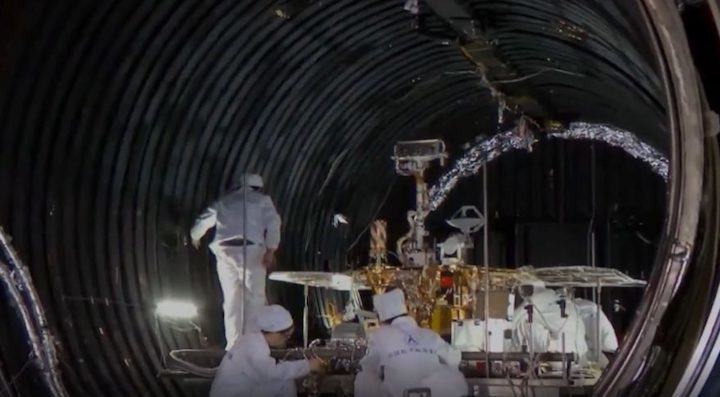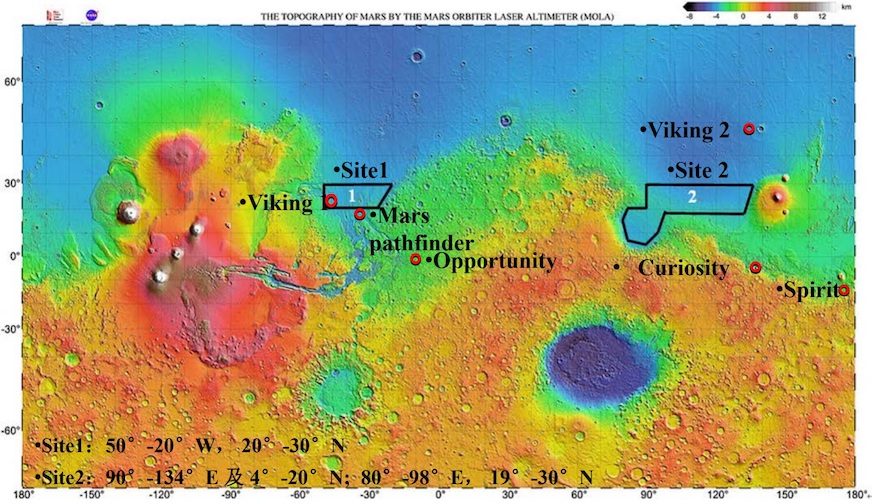25.04.2020

China's Tianwen-1 Mars mission, slated for launch in July 2020, will include an orbiter, a lander and a six-wheeled rover. (CNSA)
China revealed the name and logo for its first mission aimed at landing on the planet Mars to mark the 50th anniversary of its first satellite launch.
Celebrating the country's Space Day on Friday (April 24), the China National Space Administration (CNSA) announced that its upcoming robotic mission to the Red Planet will be named "Tianwen-1." The name, borrowed from an ancient Chinese verse by poet Qu Yuan, translates to "questions about the heavens."
"In 'Tianwen,' Qu Yuan raised a series of questions in verse involving the sky, stars, natural phenomena, myths and the real world, showing his doubts about some traditional concepts and the spirit of seeking the truth," reported the state-run Chinese news service Xinhua.
Slated to launch on a Long March 5 rocket from Wenchang, China in July, the Tianwen-1 mission will attempt to deploy an orbiter above Mars, as well as deposit a lander and rover on the Martian surface. Designed to study the composition of the Martian atmosphere, as well contribute to the ongoing search for past and present life on the planet, the Tianwen-1 spacecraft is expected to arrive at Mars in February 2021, though the probe and rover's landing may not take place until a few months later.
Few details about the mission have been released, but the Tianwen-1 lander and rover will use a parachute, retrorockets and airbags to touch down at one of two possible sites in the Utopia Planitia region. The solar-powered, six-wheeled rover, which is expected to receive its own name by a popular vote at a late date, was developed to operate for at least three Earth months once on the Martian surface.
If the Tianwen-1 mission is successful, China will become either the fifth or sixth government to place a spacecraft into orbit around Mars, the third to land and the second to rove the planet. The U.S., Russia, the European Space Agency and India have all successfully circled probes, while the United Arab Emirates' (UAE) first Mars orbiter is slated to launch from Japan during the same July to August window as China is targeting. (The U.S. and Russia are the only nations to land on Mars to date and the only rovers have been sent by the U.S.)
The Tianwen-1 mission marks the second time that China has attempted to orbit Mars. The country's Yinghuo-1 orbiter was launched with Russia's Phobos-Grunt mission in 2011, but its rocket failed before leaving Earth orbit.
In announcing the Tianwen-1 name on Friday, CNSA chief Zhang Kejian said that his agency intends to use the title for all of its planetary exploration missions, "signifying the Chinese nation's perseverance in pursuing truth and science and exploring nature and the universe," Xinhua reported. CNSA previously landed two Chang'e probes with Yutu rovers on the moon, including the first mission to touch down on the far side of the lunar surface, a mission that remains active today.
CNSA also revealed a logo to represent to its Tianwen exploration program. Shaped like the letter "C" for China, the emblem also depicts planets in orbit. The Tianwen-1 version of the logo includes the word "Mars" at its bottom.
In 2017, China released a shortlist of eight names and logos for the Mars mission, including Tianwen. A public vote was expected to choose the winner, but none of the eight candidates matched the logo revealed on Friday.
China's Space Day, celebrated annually on April 24, marks the anniversary of the country's first orbital launch in 1970. The Dongfanghong I ("The East is Red 1") satellite broadcast China's de facto national anthem (by the same title of as the satellite) for 20 days.

The logo for the China National Space Administration's Tianwen-1 Mars mission features a stylized "C" for China. (CNSA)
Quelle: CS
+++
China’s Mars mission named Tianwen-1, appears on track for July launch

HELSINKI — China has named its first independent interplanetary mission Tianwen-1, with the combined Mars orbiter and rover spacecraft apparently proceeding towards launch in July.
The name and mission logo were unveiled at a China National Space Administration online ceremonyto mark the 50th anniversary of the launch of the country’s first satellite. DFH-1 launched on a Long March 1 rocket from Jiuquan April 24, 1970, making China the fifth country to independently launch a satellite.
Tianwen-1, meaning ‘questions to heaven’, is taken from the name of a long-form poem by Qu Yuan, a poet born in the fourth century B.C., according to CNSA chief engineer Ge Xiaochun.
The ‘Lanxingjiutian’ logo includes representations of the Latin letter ‘c’, referring to China, cooperation, and the cosmic velocity required to undertake planetary exploration. Further Chinese planetary missions will also carry the Tianwen name.
China is understood to be planning a Mars sample return mission, a Jupiter orbiter and considering possible missions to icy giants and interstellar space. A joint near-Earth asteroid sample return and comet rendezvous mission has also been proposed.
Spacecraft delivered, rocket engines tested
Few details of the Tianwen-1 mission have been released so far. The Tianwen-1 spacecraft is expected to have a wet mass of around 5 metric tons. Launch on a Long March 5 launcher is expected from Wenchang early in the short launch window to Mars open in late July and early August.
The YF-77 liquid oxygen-liquid hydrogen engines for the Long March 5 passed tests in January. The same engines were the cause of the failure of the second Long March 5 launch in 2017.
Comprehensive software and hardware tests of the spacecraft were completed in March. The spacecraft has apparently been delivered to Wenchang Satellite Launch Center.
The test launch of the Long March 5B—currently expected in early May—will likely need to succeed for the Tianwen-1 mission to proceed. Following that mission, the Yuanwang-21 and -22 cargo vessels will collect the components of the Long March 5 for Tianwen-1 from Tianjin, north China, for delivery to Wenchang on the southern island of Hainan.
Tianwen-1 orbiter, lander details
The Tianwen-1 orbiter will be equipped with a high-resolution camera comparable to HiRise on board NASA’s Mars Reconnaissance Orbiter. It also carries a medium-resolution camera, subsurface radar, mineralogy spectrometer, neutral and energetic particle analyzers and a magnetometer. The orbiter will also play a relay role for the mission rover.
The roughly 240-kilogram solar-powered rover is nearly twice the mass of China’s Yutu lunar rovers. It will carry a ground-penetrating radar, multispectral camera, a Laser Induced Breakdown Spectroscopy instrument and payloads for detecting the climate and magnetic environment. The rover has a mission design lifetime of three Earth months. The rover will receive a name through a public vote closer to launch.
China has outlined two landing areas, with a candidate landing site in Utopia Planitia. The landing ellipse is understood to be around 100 x 40 kilometers. Site selection was driven by a range of factors including flight system engineering constraints and the challenges of entry, descent and landing (EDL) on the Red Planet, and the science goals of the mission.
The Tianwen-1 spacecraft is expected to reach Mars around February 2021. However, the rover landing attempt may not take place immediately. There are suggestions that the landing segment of the mission will be conducted months later, in April. This would allow mapping and observation of the landing site, despite the availability of high-resolution NASA imagery from HiRise.
The Tianwen-1 mission will join NASA’s Perseverance Mars 2020 rover and the United Arab Emirates’ Hope Mars orbiter, which this week shipped to its launch site in Japan, in launching during the July-August Mars launch window. ESA’s Rosalind Franklin ExoMars rover has been delayed to the next opportunity in 2022.

